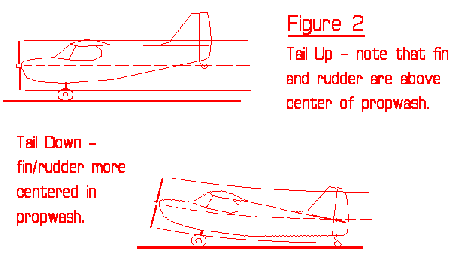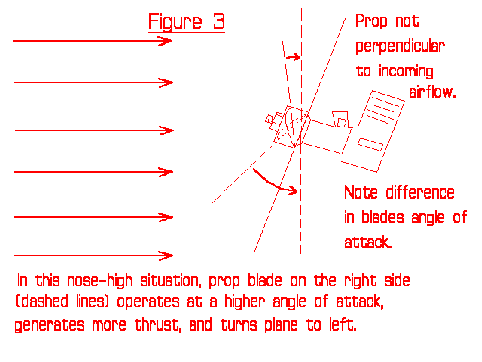

Prop Effects
-by Clay Ramskill
Often as not, when our plane does something really weird, like a groundloop on takeoff, we say, "the torque got hold of it; there just wasn't anything I could do!". Even in magazine columns we see something like: "the engines torque was pulling me to the left, so I had to jab in some right rudder".
These folks are right in that the actions of the prop were the cause of the problem - and wrong about the culprit being torque.
There are basically four "effects" from the action of the propeller; well, five if you count the thrust! They are: spiral propwash, asymmetric loading (p-factor), torque, and gyroscopic effects. We'll look at each of these in turn.
Spiral Propwash. The prop does not throw the propwash straight back - there's some drag on the prop, and that tends to make the wash behind it come off in a spiral fashion. And the problem comes when that spiral flow meets the rudder. If the rudder/fin is mounted high, the plane will turn (yaw) left because only the top part of the spiral hits it. See fig. 1. On a taildragger at rest, tail down, this may not be the case, and even the reverse may be true because the propwash must be mostly parallel to the ground. See fig. 2.


P-Factor. Asymmetrical thrust is most apparent with taildraggers because it's mostly a function of the prop not being perpendicular to the oncoming airflow - but that can also happen with any plane when at a high angle of attack, like right AFTER takeoff. When the air is coming into the prop at an angle instead of square to it, one side of the prop operates at a higher angle of attack than the other, and the resultant thrust is no longer acting on the planes' centerline, but off to one side. And that makes the plane want to turn. See fig. 3. The usual case, nose high, gives us a left turn.

Torque. Our props have a certain amount of drag - and the torque (twisting force) the engine exerts on the air is, in opposite fashion, also exerted through the engine mount to the airplane. Since all our props turn to the right, that means there is a force trying to twist (roll) the airplane to the left. Note that this force is about the ROLL axis - the torque forces do not by themselves TURN or yaw the plane as do the previous two effects. We automatically take care of this with ailerons in keeping the wings level, and it really doesn't take much force from the ailerons to do it. On the ground, all torque forces are countered by the wheels.
Gyroscopic effect. The weight of the fast-turning prop creates a gyroscope, which will resist any change in the direction of its rotating axis. This is easily overcome by the planes controls - but the more detectable gyroscopic effect comes AS THE DIRECTION IS CHANGING. As the planes direction is changing, as in a sudden pull-up, gyroscopic forces try to rotate the plane about an axis 90 degrees to the axis you're forcing it. In the example of a sudden pitch up, the gyro action from the prop will try to force the plane to turn (YAW) to the right. Don't believe it? Try it - the next time you're holding your plane nose up at full power to check your mixture, rotate the plane sharply nose up and down. You'll feel the sideways pressure from this force. In flight, its almost negligible, except perhaps at near zero airspeed if you do a VERY quick stall turn or flopover.
So what is one to do? Answer- know what your planes characteristics are, and compensate - with THE RUDDER! Let's take an example; the Piper Cub, well known for its tendency to ground loop on take off. Here's what happens: you gas the engine, and immediately have to put in some right rudder to keep it from turning to the left, from the p-factor on the prop. With the tail down, the tailwheel gets more effective as you begin to roll, and you have to let up on the rudder. But then the tail comes up - and the fin and rudder, which were low and were getting equal right and left yaw from the spiral effect, now pop up into only the top portion of the spiral propwash. The Cub will now sharply turn left unless you are quick to shove on the right rudder. As the Cub accelerates, the fin/rudder get more straight airflow and again you must let up on the right rudder to keep it straight! Whoo! And we're not even airborne yet!
One method to tame the initial gyrations is to hold the tail down for part or all of the take off run - this keeps the tailwheel firmly in contact with the runway, stabilizing directional control considerably. A touch of up elevator does wonders here; just remember to slack off the elevator at lift off to keep from climbing too steeply.
Suppose you pull the plane off early, while very slow. You are at a high angle of attack, and the p-factor (and maybe some spiral effect, too) will try to turn you to the left again. Assuming that you keep the wings level with aileron, RUDDER is the proper way to correct the left drift. If you only correct with right aileron, the plane will be in a skid, in unbalanced flight, and you're setting yourself up for a stall/snap/crash, bigtime!
Just how much prop effects affect your planes behavior depends on the plane. A pattern-type plane is affected very little. A front engined delta, which can operate at very high angles of attack (lots of p-factor) and has a very high tail (spiral propwash), is affected considerably - you get a sore thumb from standing on the right rudder. And your planes probably fall somewhere in between those two extremes.
Understand what is happening with your plane - and learn to make the PROPER corrections (quite often with right rudder). You'll be a better, smoother pilot, and you may just save a plane or two!
Site maintained by QSoftWorks
Last Update: 10/12/97